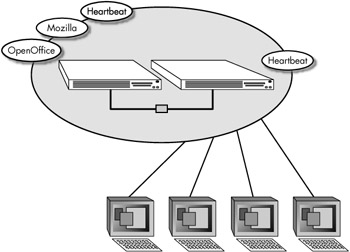The Clients
The end-user sits at a client computer and accesses the services offered by the cluster using code (objects) at the presentation tier. The client computer can be any type of operating system capable of running the presentation tier application. This includes desktop machines that contain a local copy of an operating system and all of the application code stored locally on their disk drives (fat clients) and desktop machines that boot from a centrally stored copy of the operating system where the application programs reside (Thin Clients). One type of Thin Client based on Linux is called the Linux Terminal Server Project (LTSP) Thin Client (see http://www.ltsp.org). LTSP Thin Clients run the LTSP client software on old PC hardware or small, diskless workstations designed to run LTSP (see http://www.disklessworkstations.com). The clients can then run X applications that run on Linux, such as the Mozilla web browser or the OpenOffice suite of applications. The LTSP server software runs on a pair of servers (to provide high-availability), as shown in Figure 20-3.

Figure 20-3: High-availability LTSP servers and Thin Clients
Notice in this configuration that all requests for cluster services originate from the LTSP servers, because the X applications will normally run on the CPU of one of the LTSP servers.[2] Thus, care must be taken to ensure that load balancing works properly when all of the client requests originate from a single IP address (as discussed in the section entitled "LVS Persistence" in Chapter 14).
| Note | It may be possible to build an LVS cluster in which all real servers run the LTSP server software. Depending upon your situation, however, this may make it harder to maintain both the LTSP server software and your mission-critical applications, if they must run on the same machine (a cluster node). A cluster that runs presentation and business tier objects, in other words, may not be the ideal cluster. |
[2]Although LTSP clients can be configured to run applications on the local CPU of each Thin Client.
EAN: 2147483647
Pages: 219